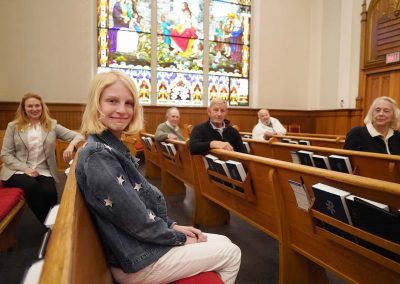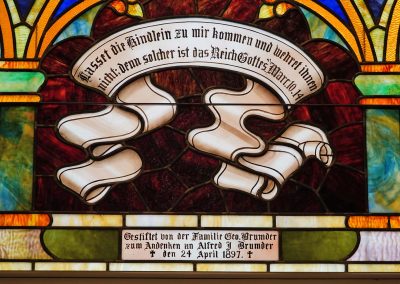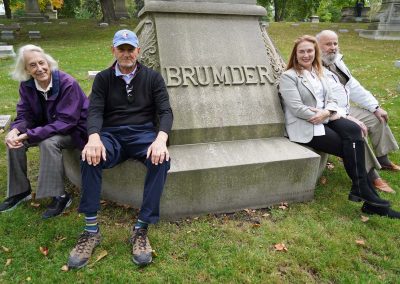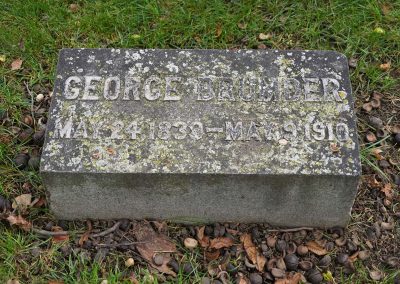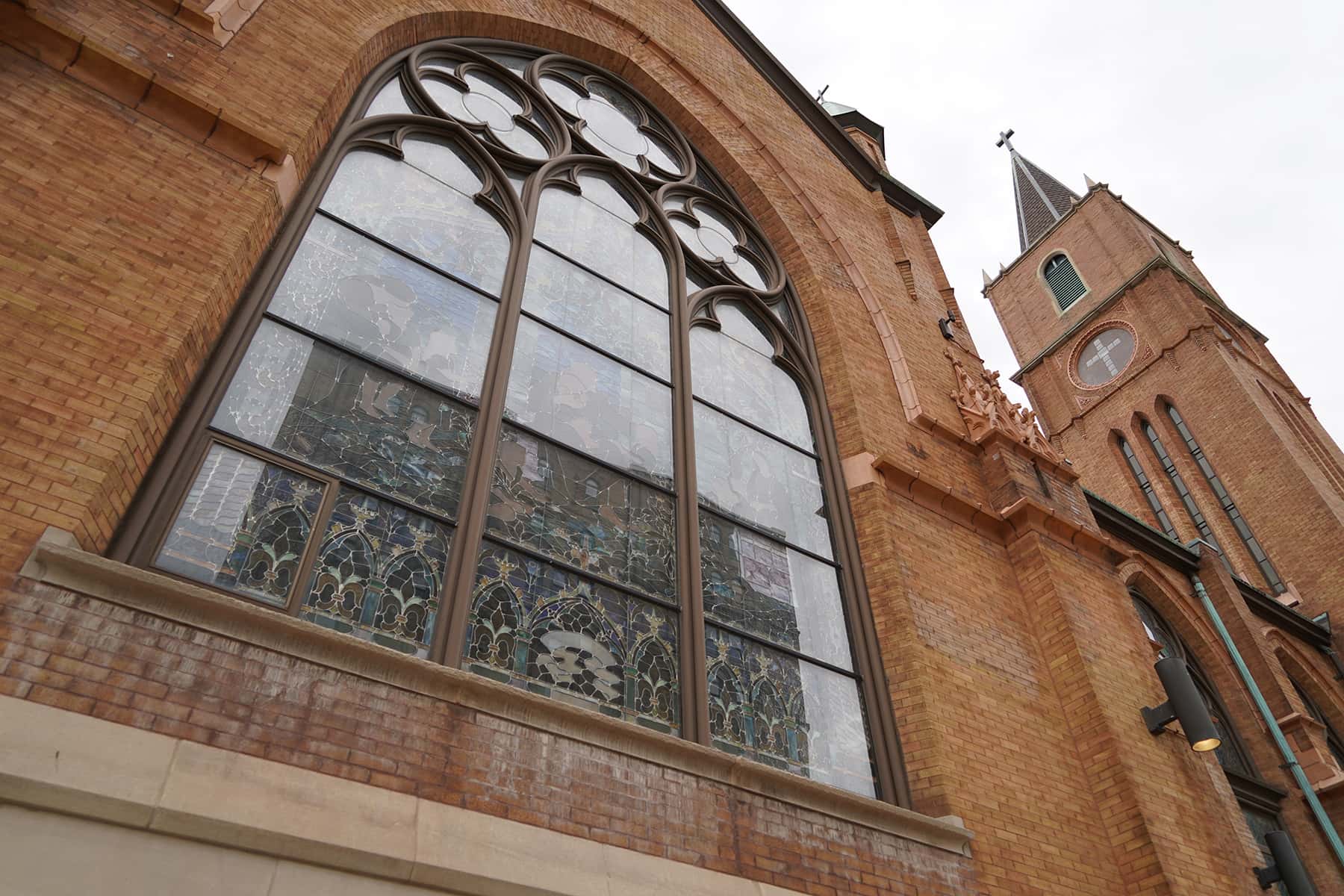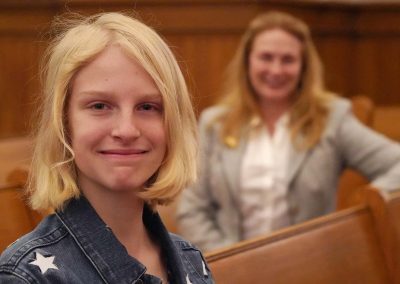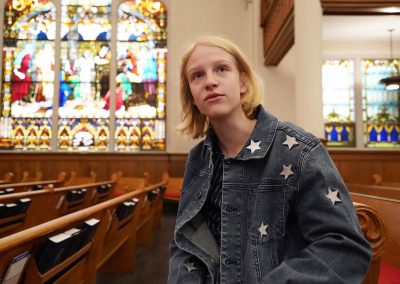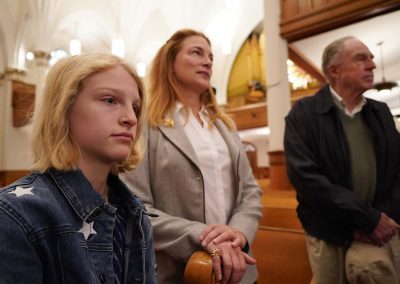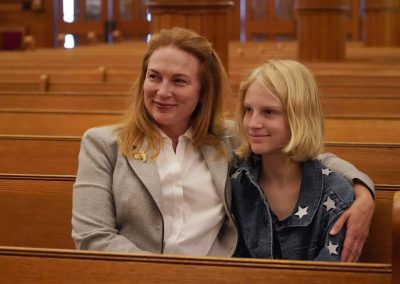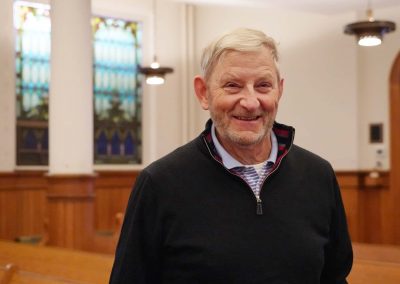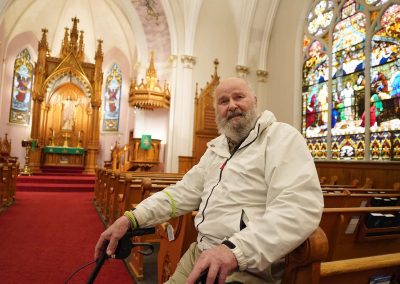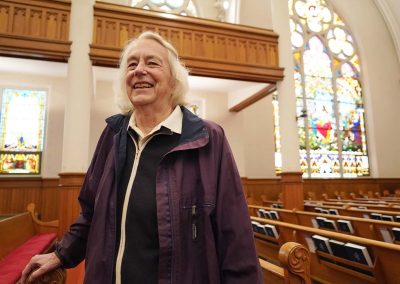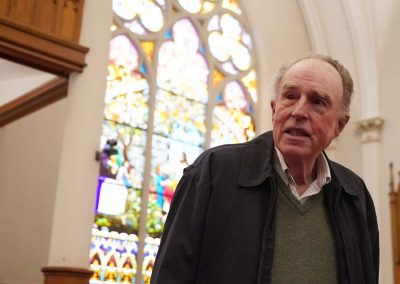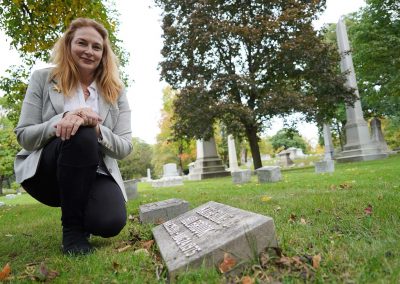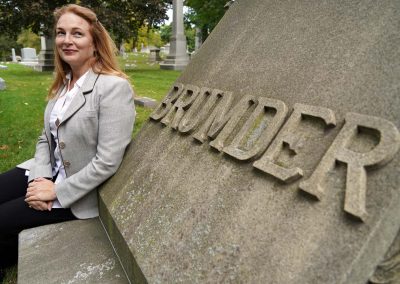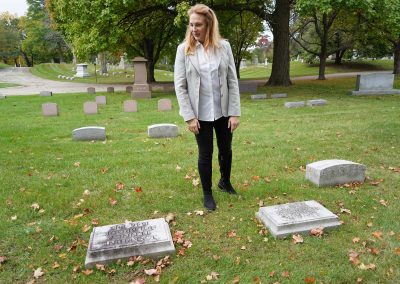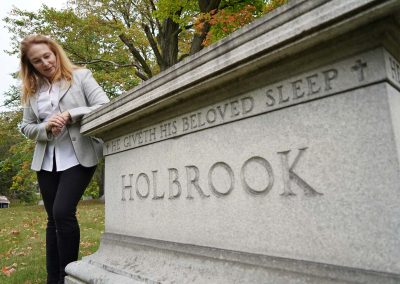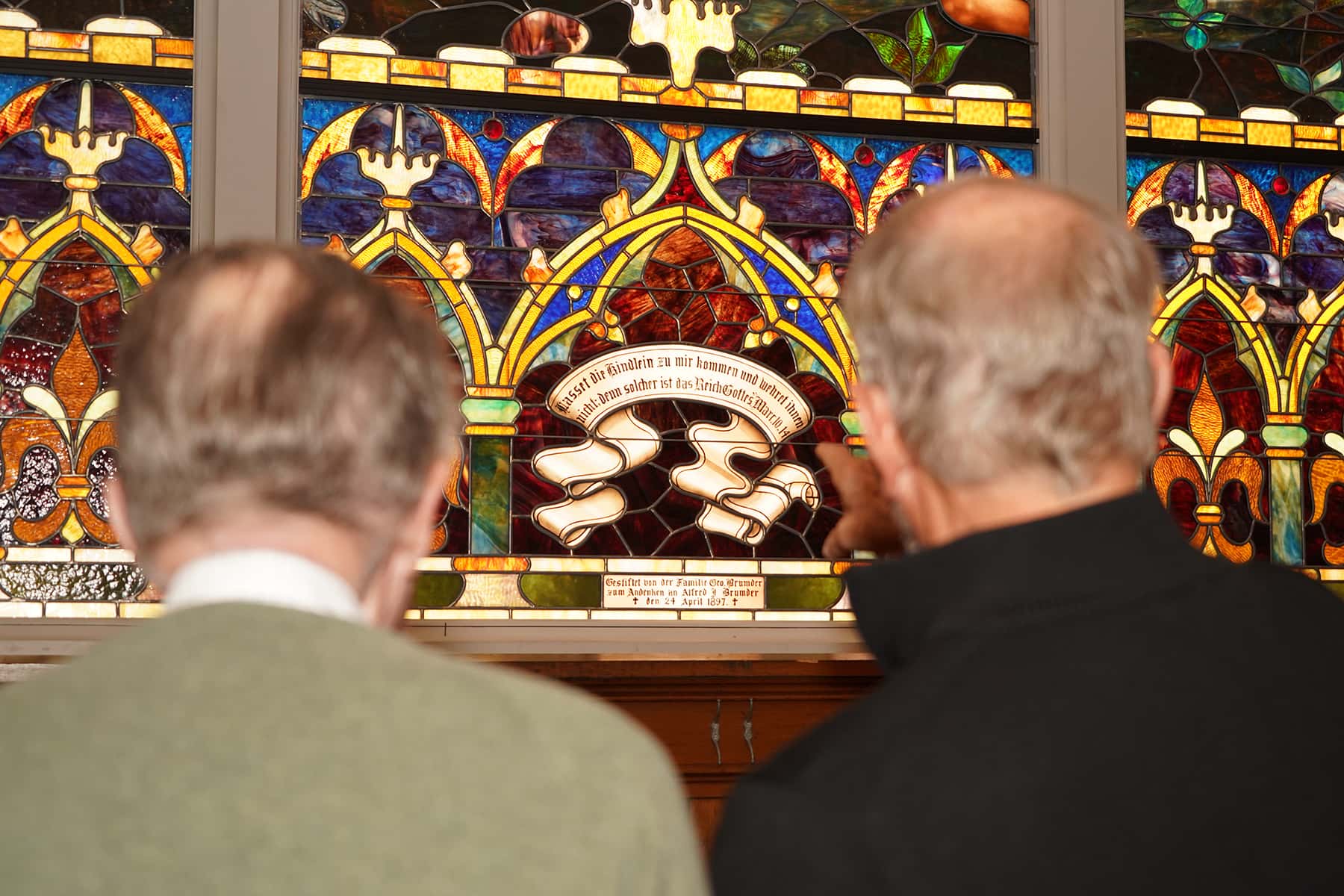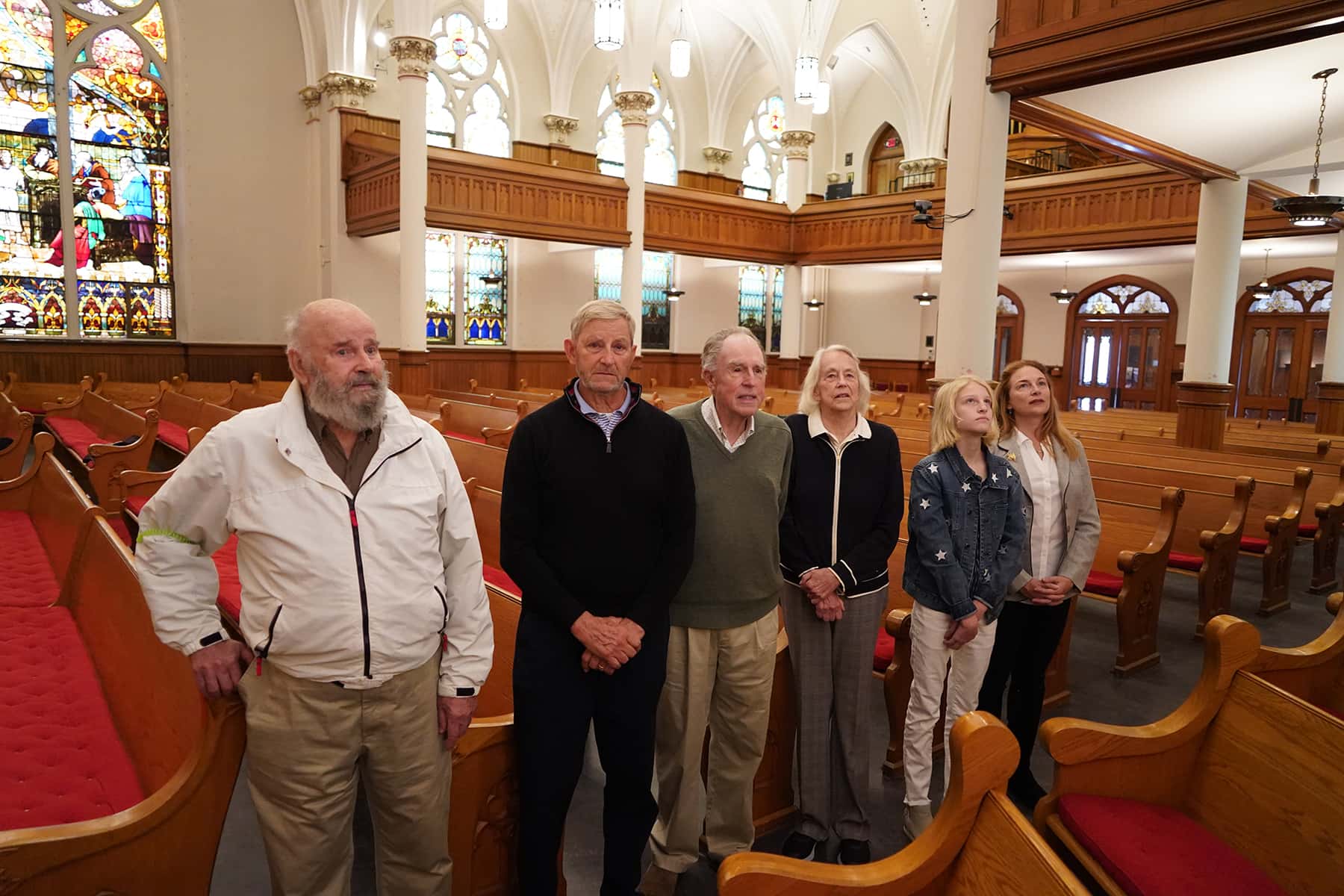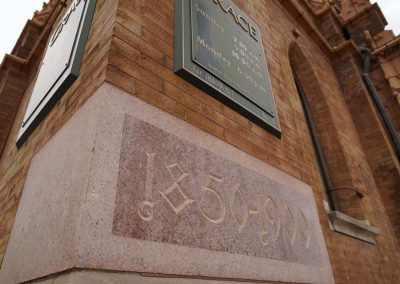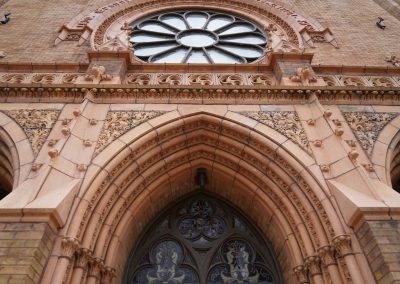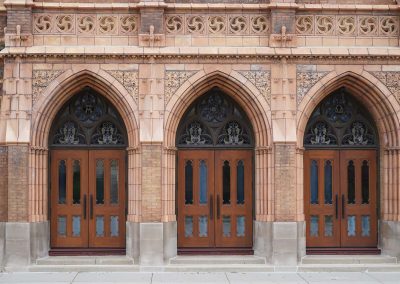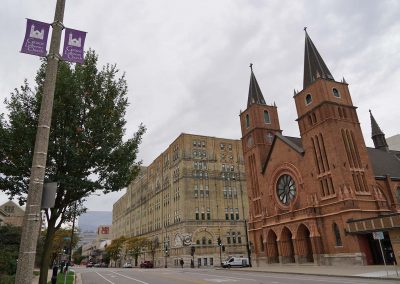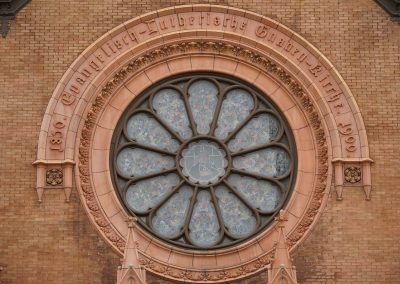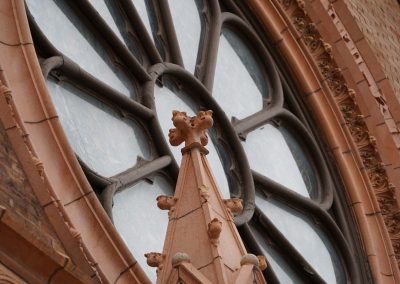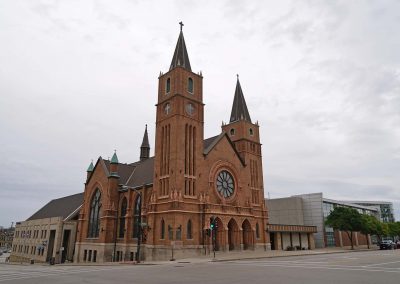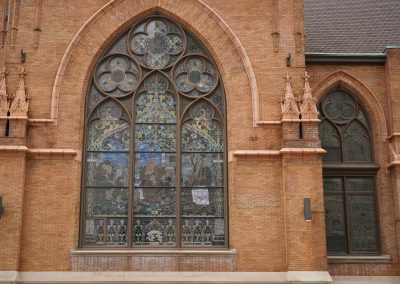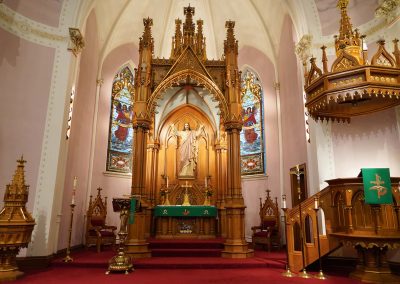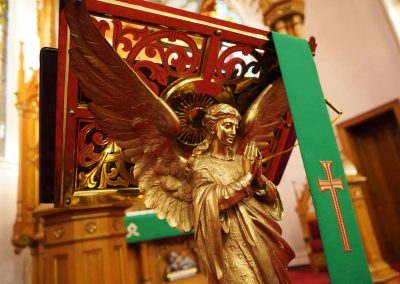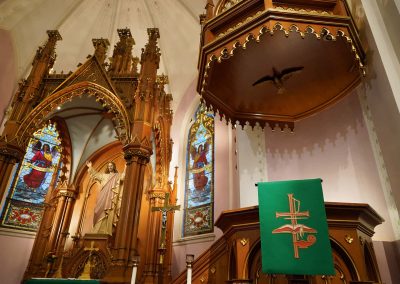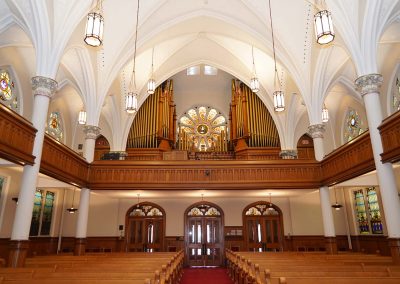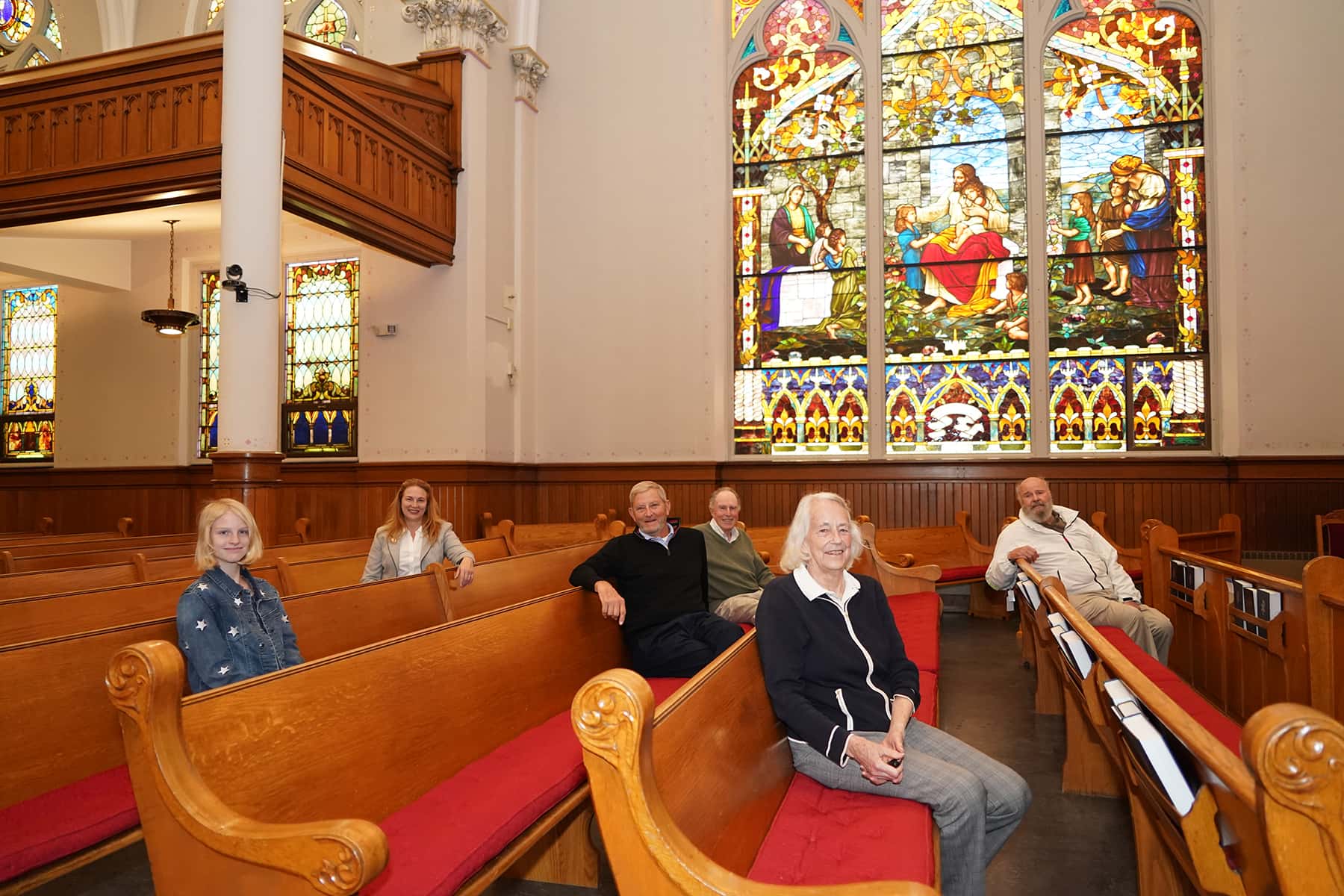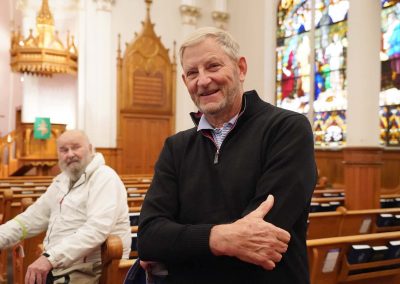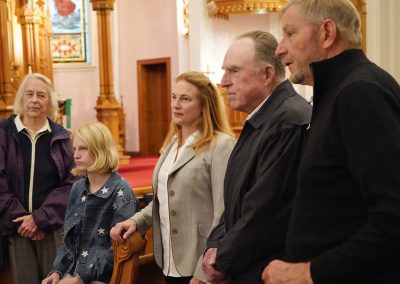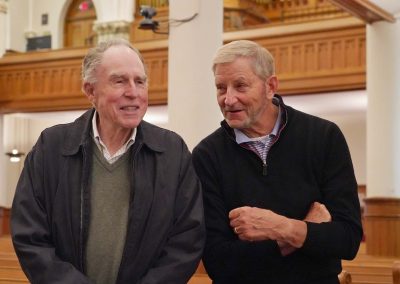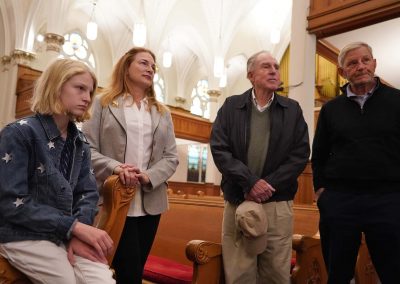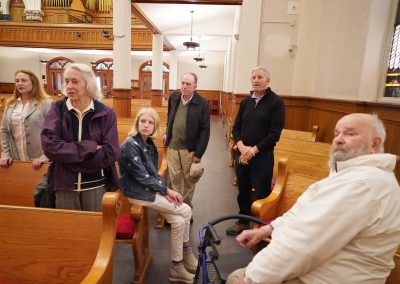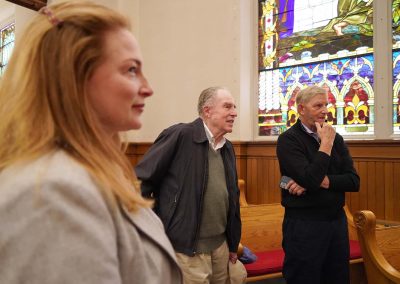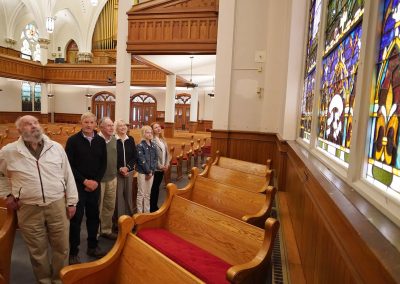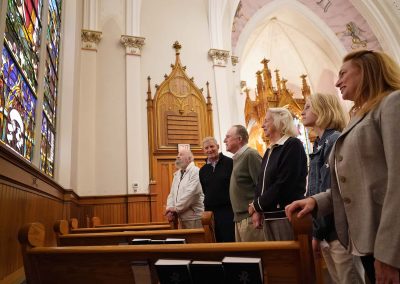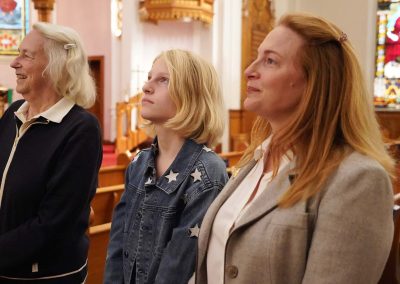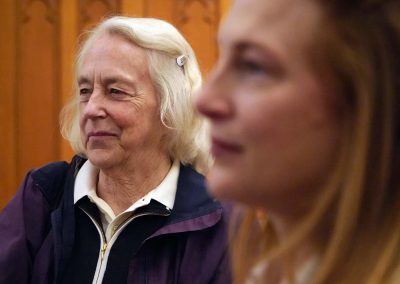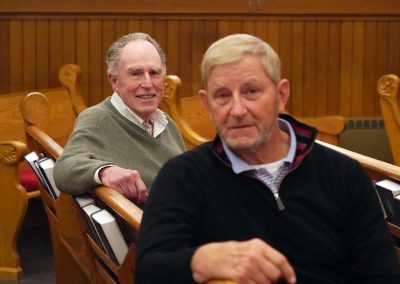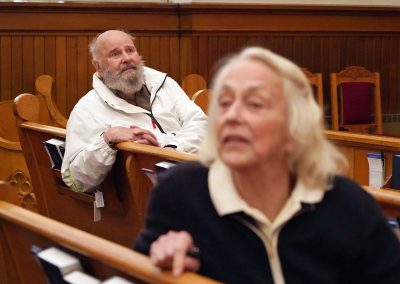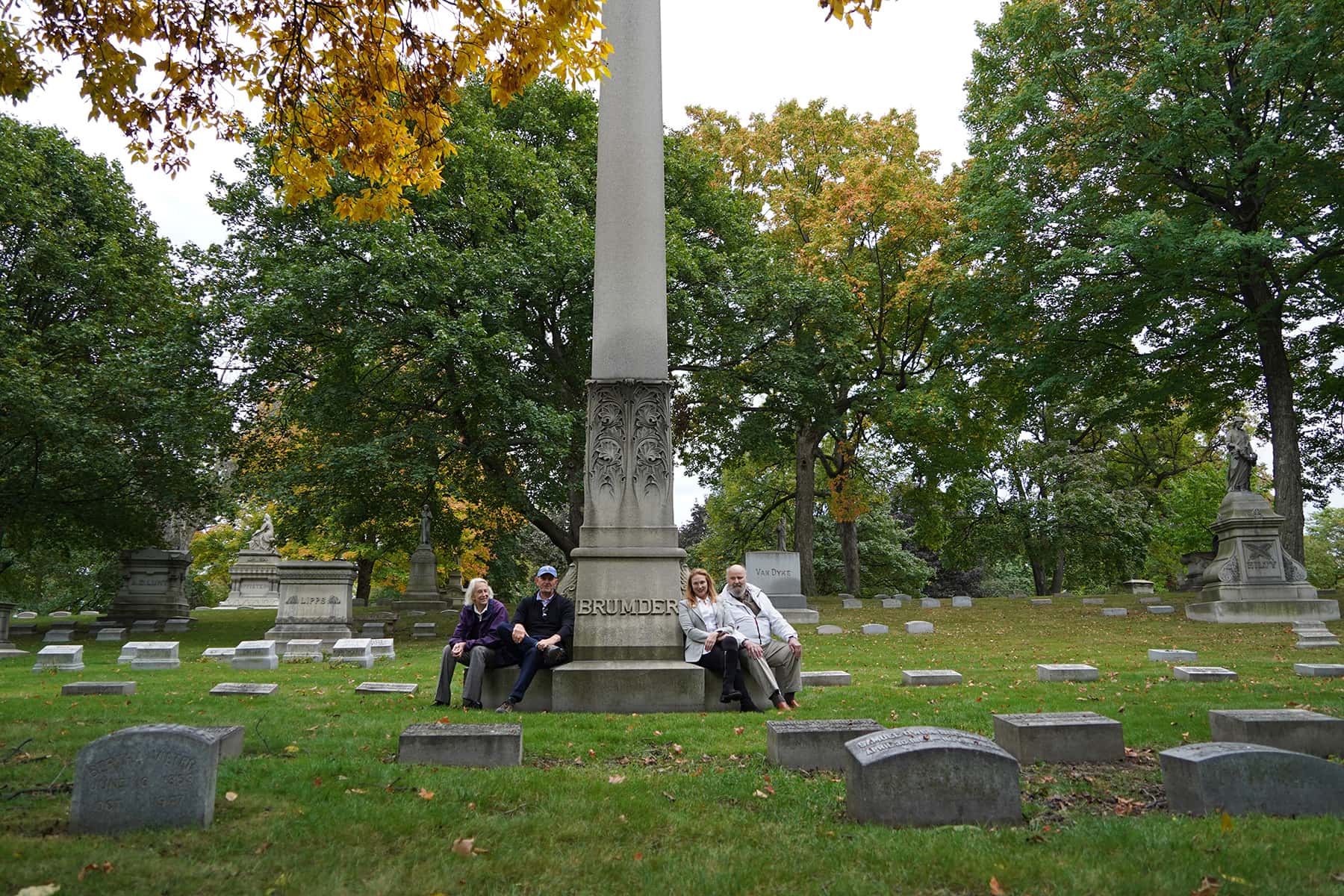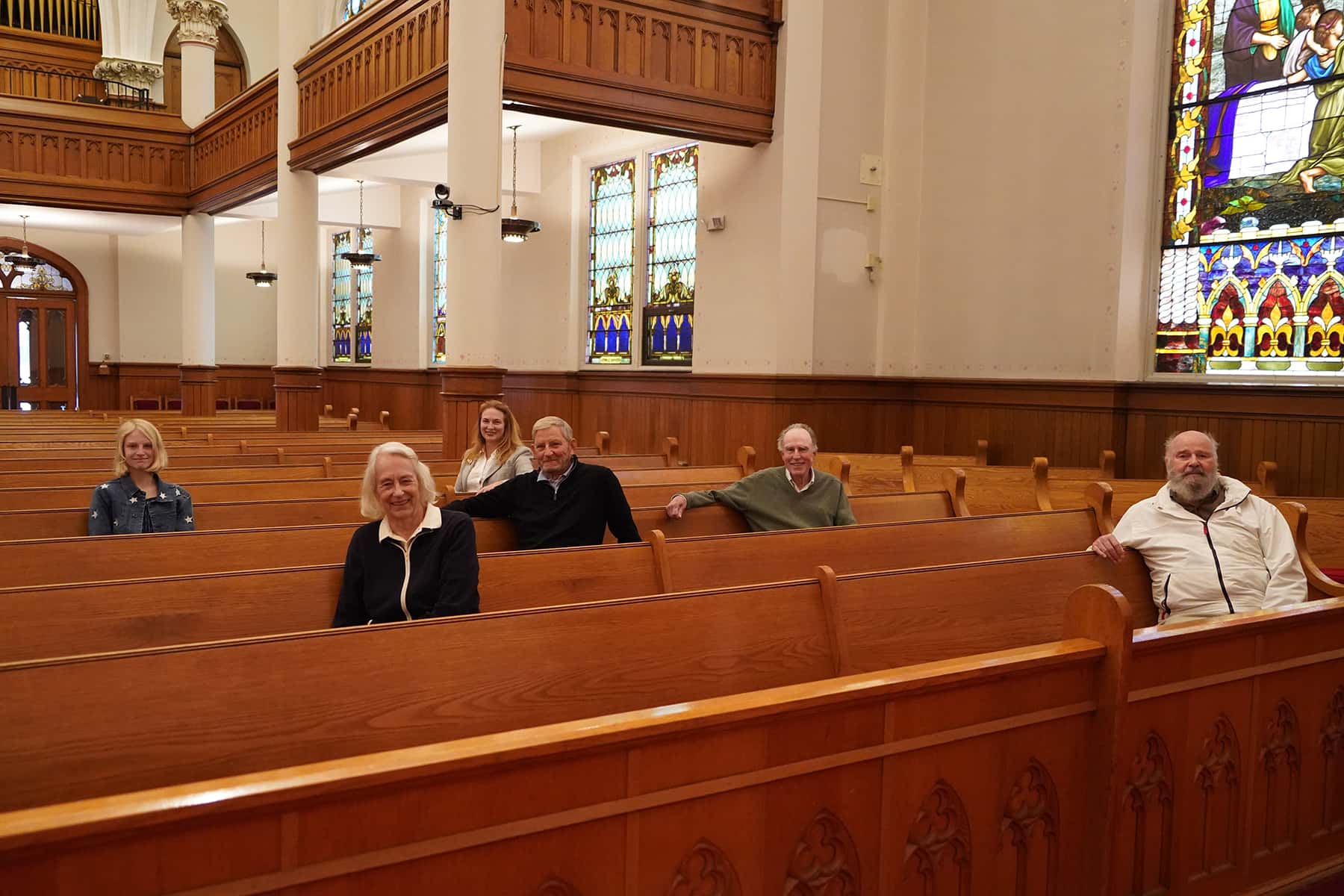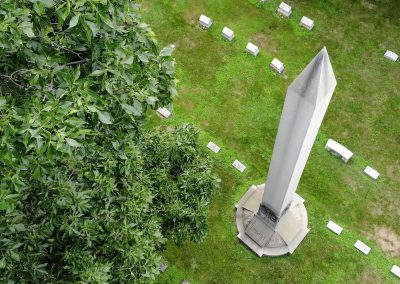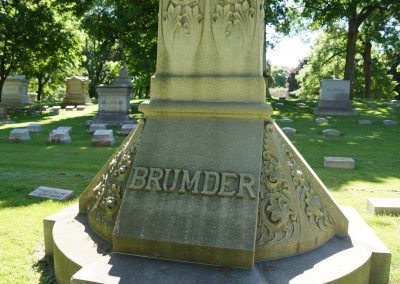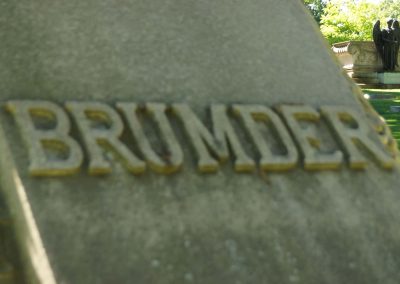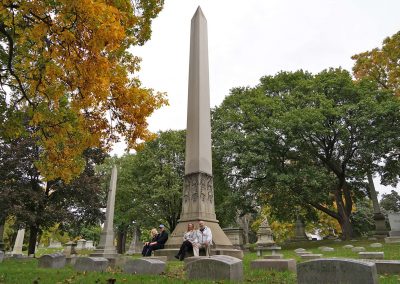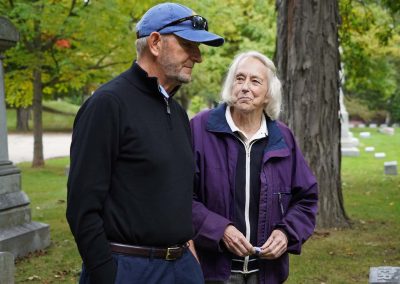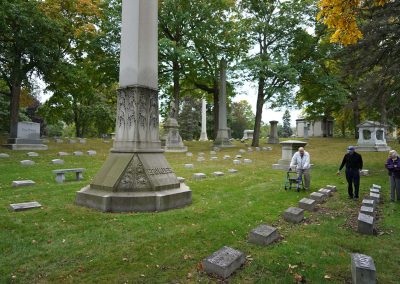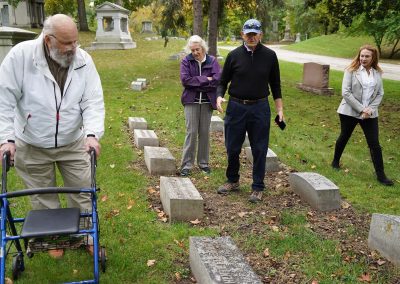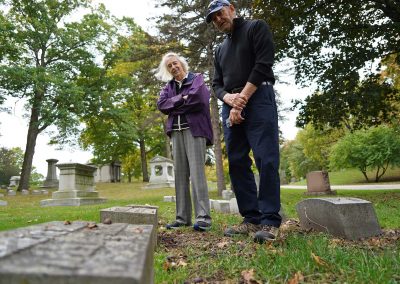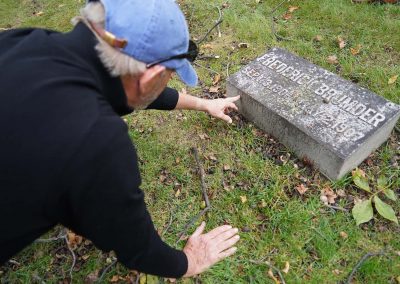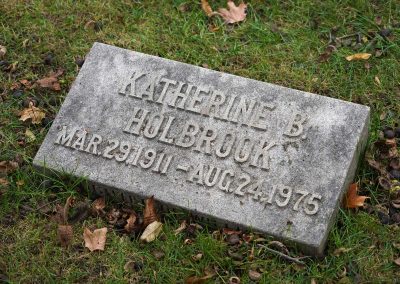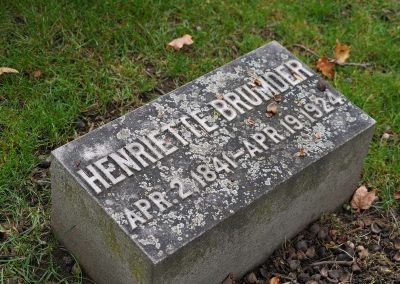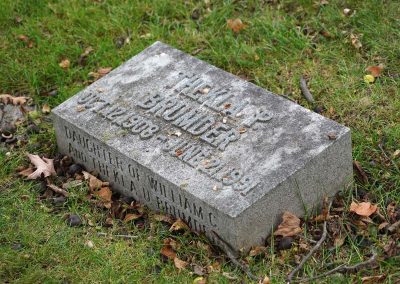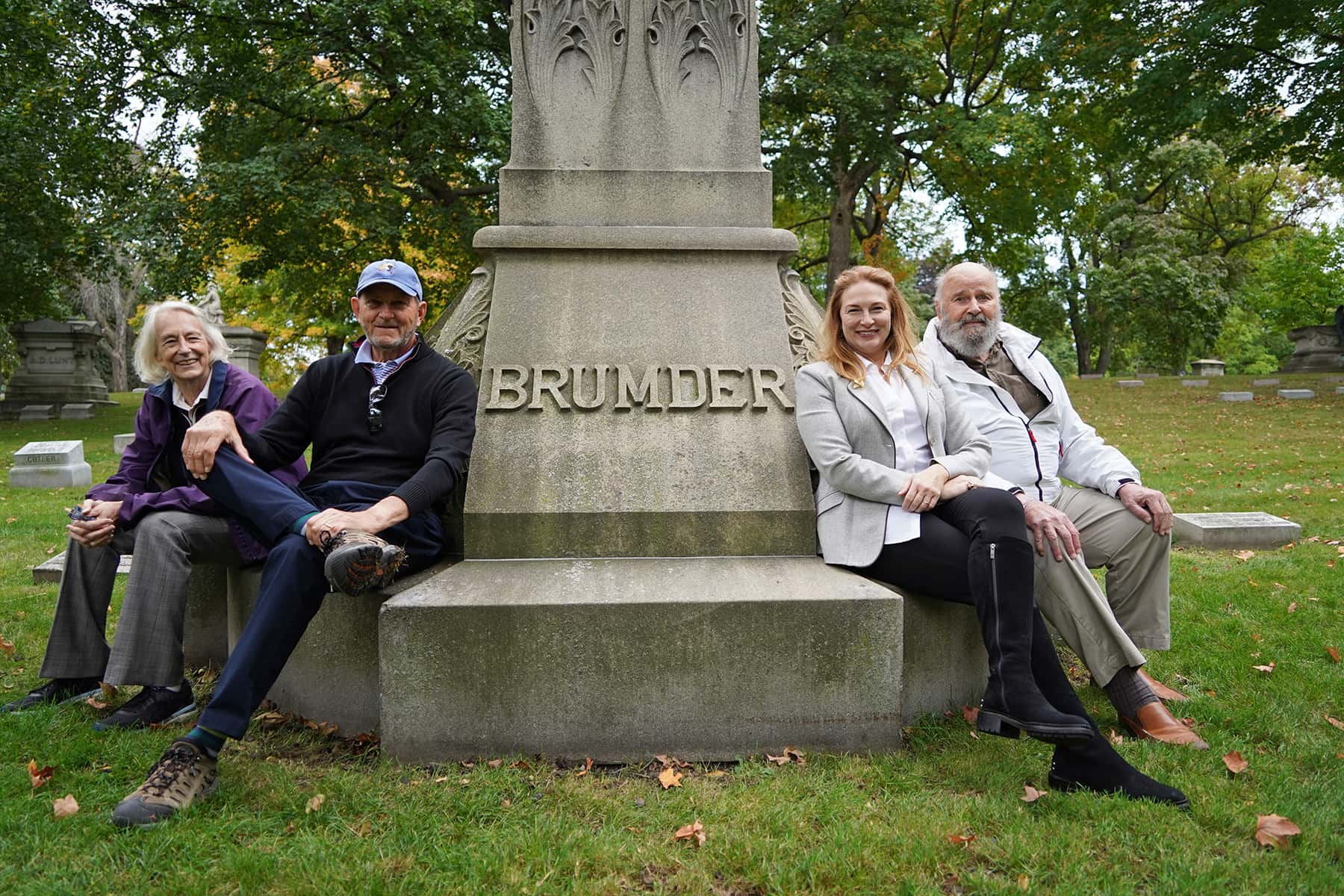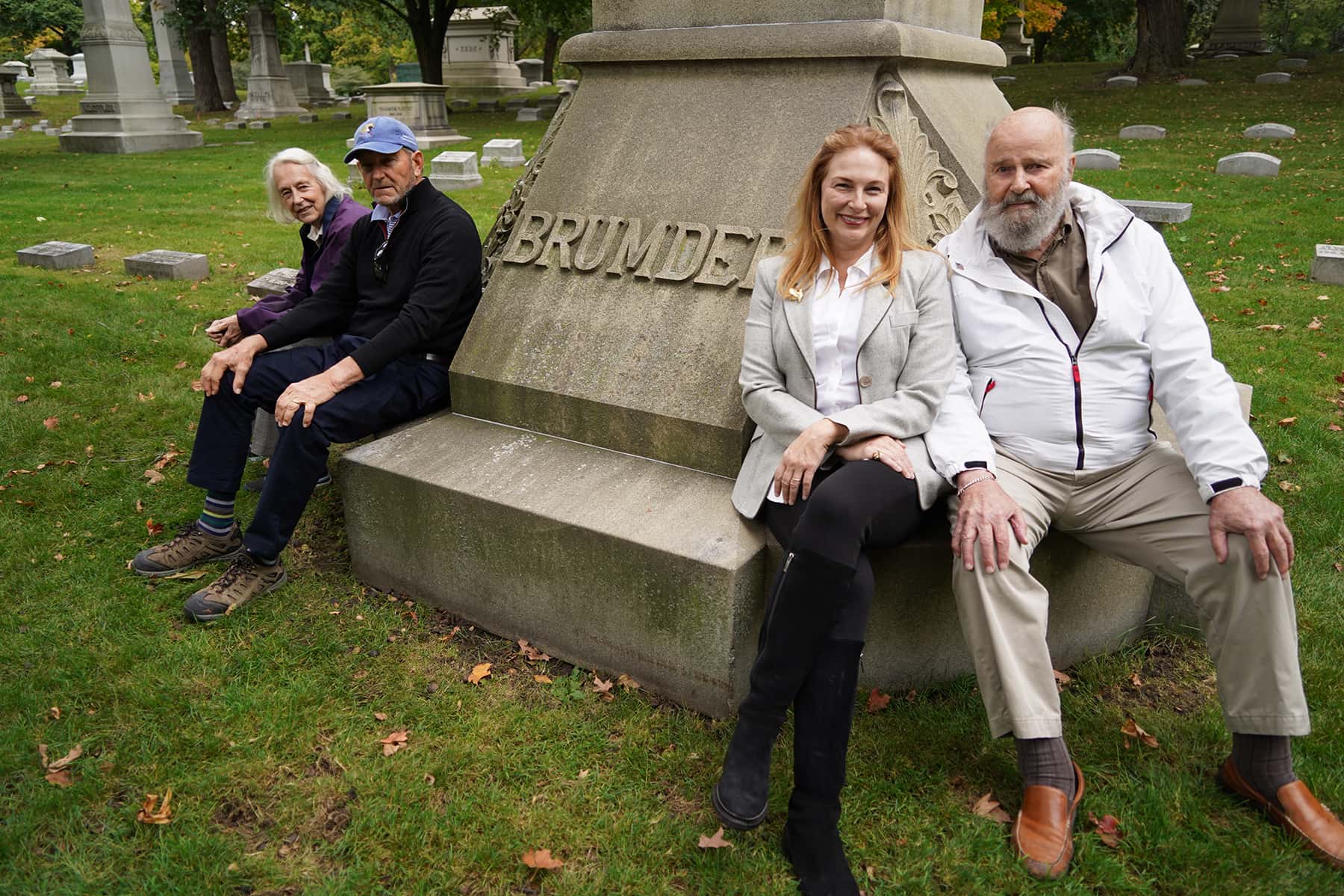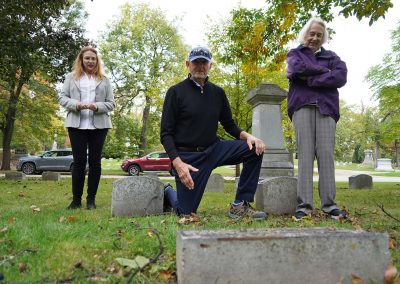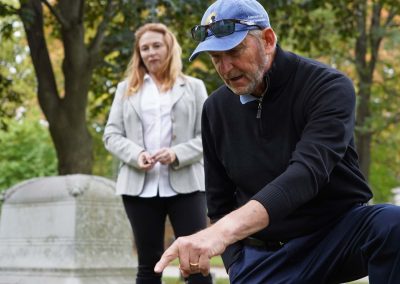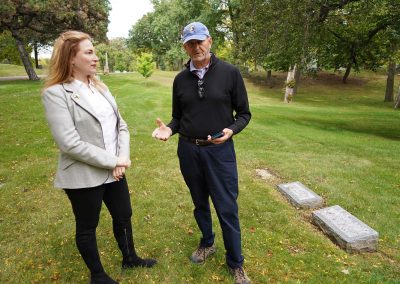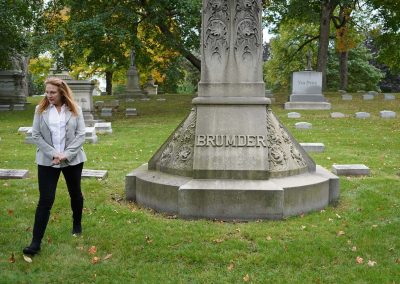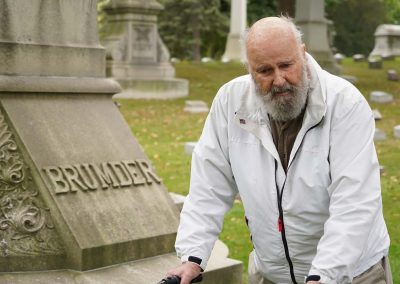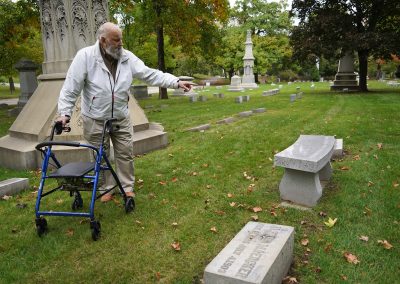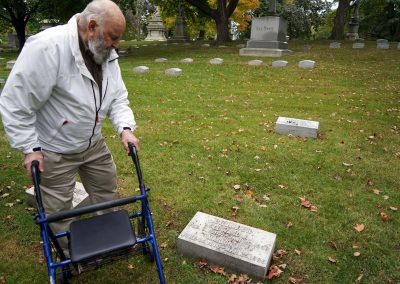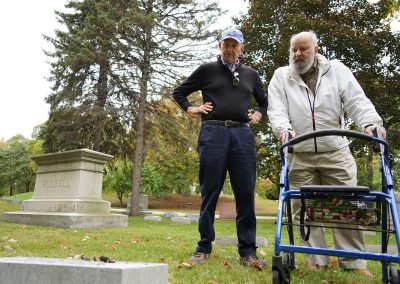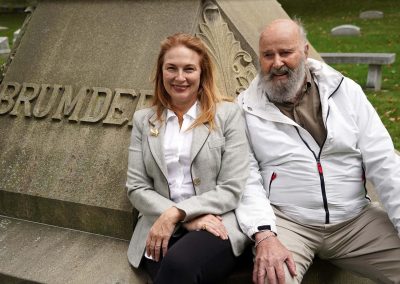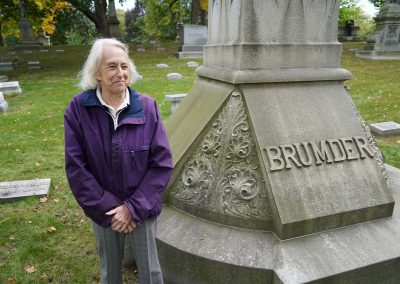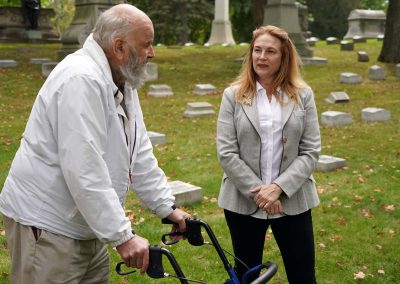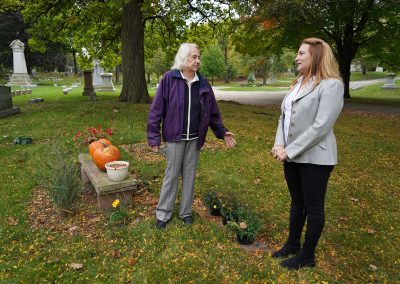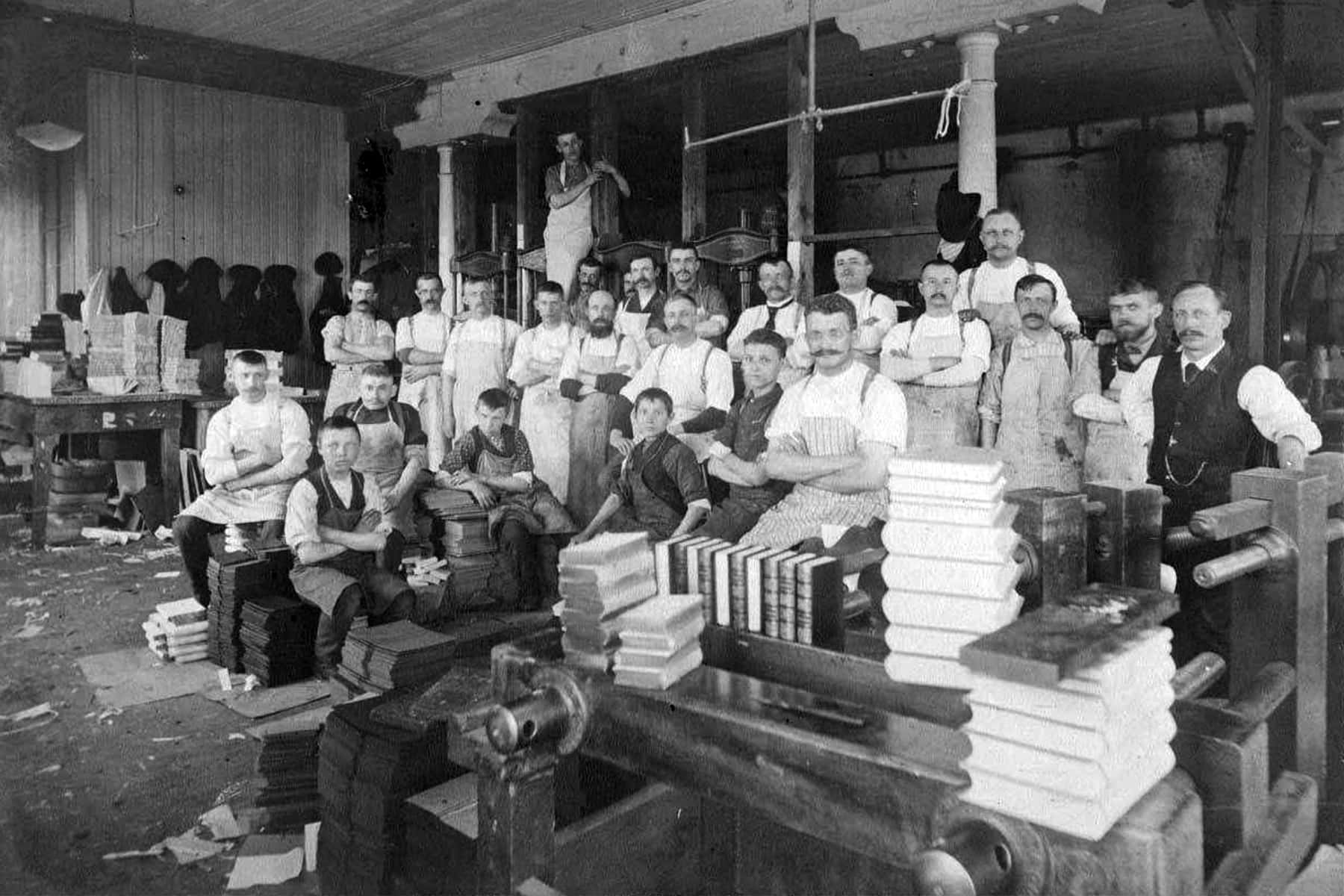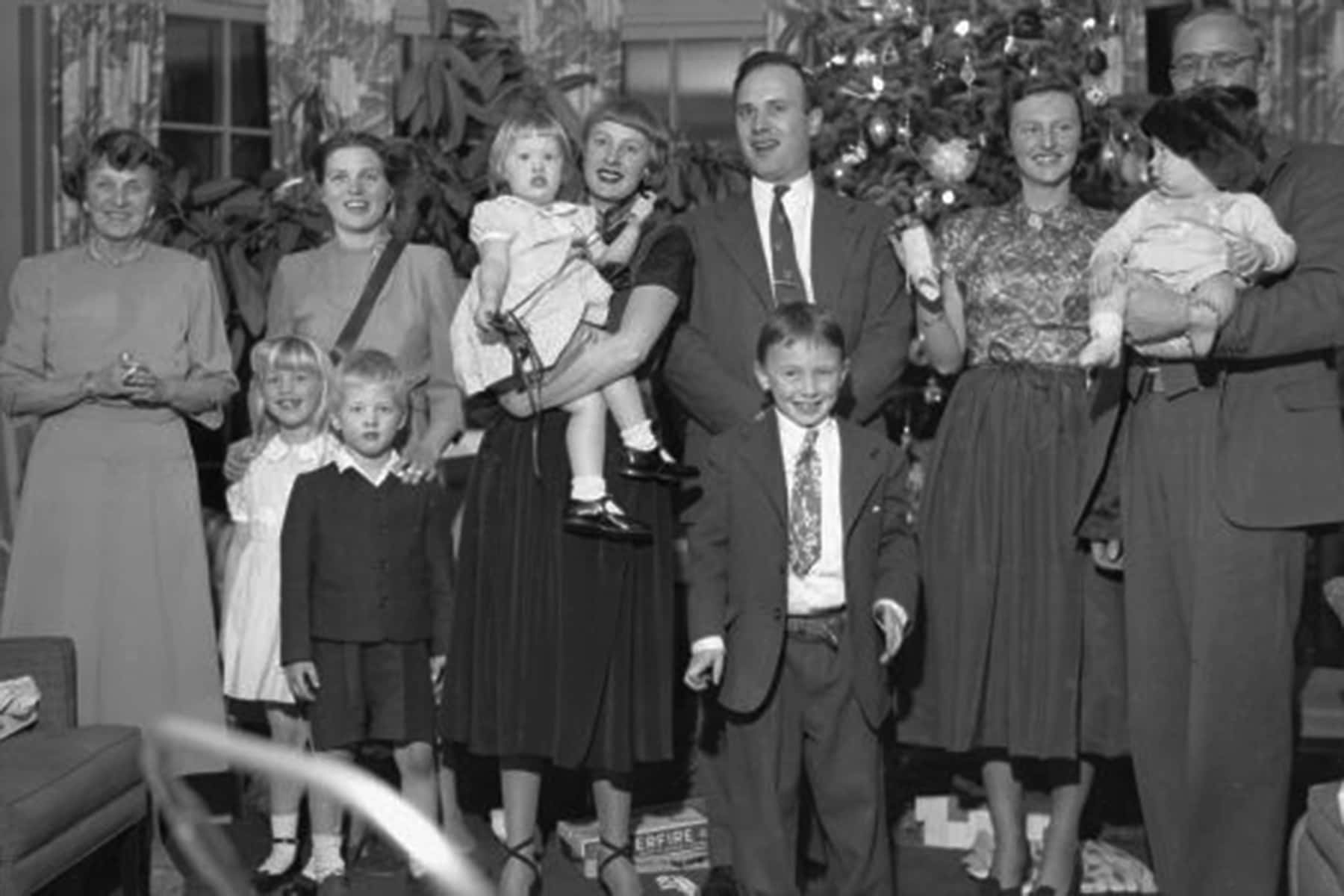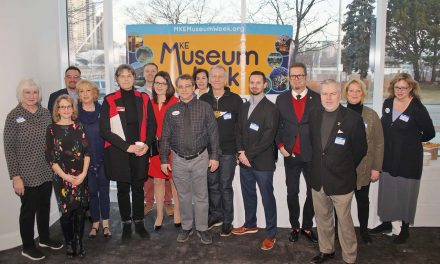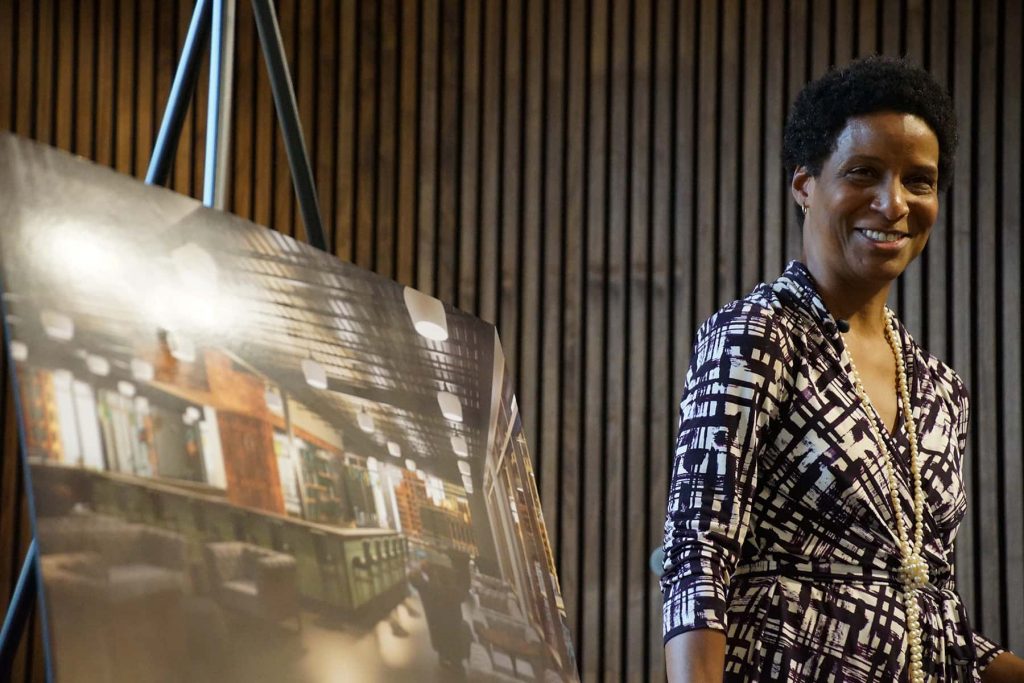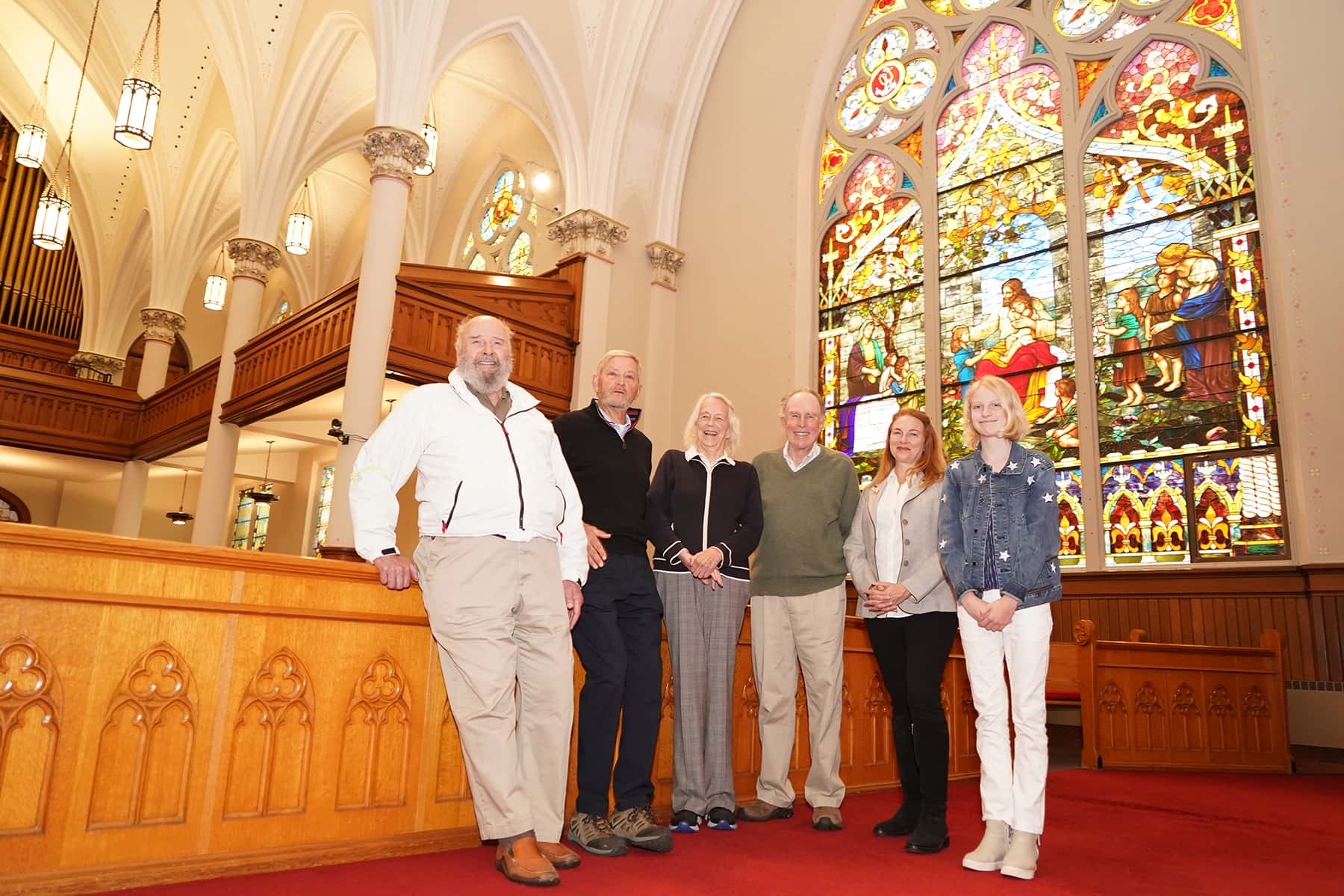
Members of the Brumder Family at Grace Lutheran Church from left to right: E.J. Brumder, Robo Brumder, Valerie Patricia Brumder, Matson Brumder Holbrook, Sarah Holbrook Slaughter, and Ada Slaughter.
As thousands of German immigrants came to Milwaukee in the middle of the 19th Century, Grace Lutheran Church was built on the corner of Broadway and Juneau Avenue. Its congregation has worshiped there ever since the dedication of the original building in 1851. And descendants from one of the founding families still call it their place of worship today.
At the age of 18, George Brumder emigrated to Wisconsin in 1857 with his older sister. Shortly after arriving, he set off on a 45-mile journey by foot to the city of Milwaukee. Brumder soon joined the newly established Grace Lutheran Church, where he met his future wife, Henriette Brandhorst.
With the investment of what little money they had in 1864, the couple opened a small bookstore on Water Street. Brumder had built a publishing empire by 1896 that included the largest German-American newspaper in America, based in the new 8-story Germania Building. Brumder’s business and community contributions helped guide the early development of Milwaukee, with a formative impact on Wisconsin and the United States.
George and Henriette would go on to have eleven children, seven of whom survived them. The Brumder Family plot is located at Milwaukee’s historic Forest Home Cemetery.
The Brumder Family Tree today is comprised of thousands of descendants dispersed among different branches. And some of those family members still live close to their roots in Milwaukee after six generations. The modern-day story of Grace Church and the Brumder family continues with Sarah Holbrook Slaughter, born and raised in the Milwaukee area and a fifth generation Brumder kid.
“I went away to college, met someone, came home, married this guy from out-of-town, and had a child. Then it came to the point when we really needed to find a good home church that suited both of us, with our different faith backgrounds, and one that would work for our daughter,” said Slaughter. “My father had mentioned to me that the congregation at Grace Evangelical Lutheran Church downtown was really growing. It was a great place for young people and for young families. From everything he had heard, it should be something we considered.”
With husband Will Slaughter and daughter Ada, who was a year and a half at the time, the family simply walked in one day and attended worship services at Grace.
“I could not believe how many kids were there, how many little kids. It was a church where they wanted families and young children in the pews. They wanted the kids to learn how to sit through a sermon, even if it was boring, and to be part of the life of the church,” said Slaughter. “So we started simply, just going and listening. We found that it was a really lovely and active environment with a lot of good energy.”
After getting to know the church leaders, including Head Pastor James Huebner, and warming the pews for a couple years, the Slaughter family decided to become more deeply involved with the church. About a year of classes helped them explore Grace’s particular denomination of Lutheranism, which is WELS (Wisconsin Evangelical Lutheran Synod). A decade later, daughter Ada is now going through confirmation class.
“I had always known that this was historically the Brumder Family church, but I think I had only gone in the church once before for a Brumder reunion,” said Slaughter. “Once we started going there on a regular basis as a family, my great, great grandfather’s photo was pointed out to me – George Brumder, as one of the church founders. Then a little while later, while I was looking at one of the beautiful stained glass windows, someone told me that it was donated by George and Henriette Brumder in memory of their son who had died – Alfred Julius Brumder.”
Alfred Julius Brumder had attended Yale University in the late 1890s. All the Brumder sons received an education and were involved with the family business, but to leave the Midwest for a school back East was a particularly big deal to a German immigrant family. As one of the first children born in America, many of the Brumder Family hopes for the future rested on Alfred’s shoulders. It was a familiar immigrant dream that continues to this day.
By all accounts, Alfred was gifted with an adventurous spirit. He had travelled to Hawaii, and the registry at Volcano National Park has his signature and notes from the visit. He was just beginning a life that promised so much when he ended up dying of a rare brain infection, believed to be meningitis.
“He was at Yale, away from family, and it happened very quickly. The pain that must have caused, and also how his death was talked about over the years. I think it really loomed large in the family, and became a mythic story of this hope that was crushed. So maybe it was too painful for some members of this German immigrant family to go back to Grace Church,” said Slaughter. “What I love about the story of this particular window is that it was given by my great, great grandparents in memory of their son. But it also happens to be a window about the parable from Matthew 19:14 in the New Testament, ‘Suffer the little children, and let them come to Me.’ It talks about how we should have childlike faith. The image that is used shows all these little children who are coming to get to know Jesus. And His attitude is… come sit on my lap and let’s hang out.”
Slaughter said that she originally did not know about the history of the massive stained glass window facing the south side of the church building, other than the family connection. But as she got more involved with the church and its many volunteer activities, she was asked to sit on the committee in charge of restoring it. Decades of environmental conditions had left it in need of repair. Slaughter found it to be the perfect experience for her. Three different restoration companies were considered, with Milwaukee-based Conrad Schmitt Studios being the best choice.
“Grace Lutheran has done a great job keeping records and historical documents, about what has taken place at the church. But there was no information about who made the original window, or why they picked that design. We just know who gave it, when, and why,” said Slaughter. “The good thing about working with Conrad Schmitt, all of us on the committee learned so much about stained glass, painted glass, the whole production process. During the restoration, we had a chance to go to the studio and get a tour. We saw big portions of the window all laid out on tables being cleaned, and being put back together. It was painstaking and it took months.”
Conrad Schmitt had a trove of drawers with individual pieces of glass. And even if something was broken, or missing, or they did not have something already in their historical archive to use, they could easily replicate it and then cut to fit. When the restored window was reinstalled, a protective covering was added outside. Because some cheaper plastics could discolor and turn yellow over time, the committee researched what covering material to use that would remain clear.
The beautiful design and vibrant colors of the window now serves as a destination of interest for passersby, attracting their interest to step inside the church. Slaughter said that she often looks at the restored stained glass during Sunday services. When she thinks about how many of her family members have left Milwaukee or who have passed on, seeing the window reminds her of two things.
“It reminds me of the childlike faith we need to have with God and with Jesus, and we are part of that kingdom in that family. It is a comfort,” said Slaughter. “And then to clearly see the love and devotion that my great, great grandparents had for their son, and how they must have missed him terribly. It had to be just a huge loss at that time, even though people lived with death much more than they do today. Now as a mom myself, I can really feel what that would mean, how devastating the loss of a child would be away from home.”
By the time any family gets to generation six, relationship ties are rather dispersed. Members really have to work at those connections and those relationships. For 14-year-old Ada Slaughter, her ancestors follow a direct path through Sarah Holbrook Slaughter and Will Slaughter (generation five), to Matson Brumder Holbrook and Deborah Miekley (generation four), to Katharine Elizabeth Brumder Holbrook and Matson Holbrook (generation three), to William Charles Brumder and Thekla Uihlein (generation two), and finally to George and Henriette Brumder.
“I would say that because generation three has more or less passed away now, we lack having those individual matriarchs and patriarchs which people gather around,” said Slaughter. “My branch of the Brumder Family was particularly fortunate to have a few very strong characters who everybody rallied around for decades, up until just a few years ago.”
With the death of Robert “Robo” Brumder’s father – Robert C. Brumder in 2014, the family lost the last of its patriarchs. Uncle Bobby was the youngest of the generation four siblings. He was only around 22-years-old when Slaughter’s father Matson B. Holbrook was born, and the two became very close. Uncle Bobby would often step in and be a father-figure, helping with the family.
“When Uncle Bobby passed away there was, for lack of a better term, a vacuum. Other people didn’t feel the need to come back for Christmas or whatever,” said Slaughter. “The big holidays were really the things around which we would gather. Also in summertime, going to Pine Lake in the village of Chenequa in Waukesha County. That was where the family had a foothold for generations, from the time it was just country and nothing was out there. My great grandfather owned the northwest shore, from what is Oakland Road today and all the way to Highway K. So the entire family was there, and everyone would go out for picnics. But as time goes on, the losses just create more splinters.”
That family fragmentation and transition left Ada and her generation six relatives with vastly detached experiences. Members went off to college and did not return to Milwaukee, got married, or found more interesting opportunities elsewhere. That trend reflected what was happening in Milwaukee at the time, as family businesses began to decline when children went on to pursue their own careers. As a result, many stayed away.
“Her experience with our family was just a couple of get togethers before Uncle Bobby died. And just a couple of things since. So to her it’s a little bit more out there and detached. She knows about it, but it’s not this living, breathing thing that it was for me,” said Slaughter. “It’s gotten a little empty and a little flat for my liking. When people come to town, I’m always very happy to see them. They just don’t come to town enough for me. That’s okay, but I miss them.”
Thekla Pauline Henriette Brumder was a daughter of William Charles Frederick and Thekla Uihlein Brumder, and sister of the generation four siblings. Known as Aunt Teckie, she never married but served as one of the strong and nurturing forces in the extended family. She took an active part in the lives of her nieces and nephews, and was a beloved aunt.
“Aunt Teckie used to drill the family tree into my head. She and others did a great job at trying to keep everything in order with all the branches. But Aunt Teckie just hammered it – who was related to who, who were the friends, who was divorced, who was this and that so we would learn it,” said Slaughter. “Knowing all that family history has proven to be extremely helpful to me, especially living in Milwaukee. You never know who you’re meeting. It is startling to me, the number of people I’m related to. And it’s a good thing I married somebody from out-of-town completely.”
Slaughter’s grandmother Katharine died in 1975, when she was not even two-years-old. There are some old family films and photos of the two together, but she had no working memory of spending time with her like the older cousins did.
“For my memories, what I’ve learned came from my older aunts and uncles, like Uncle Bobby and Aunt Teckie in particular,” said Slaughter. “Unfortunately the family had three of the active siblings die in the late 1970s, one, two, three in a row. My dear Aunt Teckie and I were close, and I’m sure all my other cousins would say they were close too. She just had that knack for making you feel like you were the most important and beloved little person.”
Aunt Teckie loved little kids, and she would tell the story about growing up in the big house at the corner Hartford Avenue and Lake Drive – between Marietta Avenue, which is now the UW-Milwaukee Edith S. Hefter Conference Center. She would recall being a child in that house, and her parents going out for events. One of Aunt Teckie’s dearest stories was when she was in bed and her mother would come in to kiss her goodnight. She would come in wearing beautiful evening clothes, and Aunt Teckie’s favorite memory was the rustle of the fabric of her mother’s dress.
“I had a wonderful experience, especially around holidays – and Christmas in particular, that does not exist anymore. Christmas Eve is a big deal for Germans. Now that those traditions have gone away, it is very quiet on Christmas Eve,” said Slaughter. “It feels a little bit empty, because I grew up with the holiday being such a huge deal around the Brumder Christmas. All of my generation as little kids, we lived for it because that was the big night we got dressed up. We saw all our cousins. It was a free-for-all with great food, lots of songs. Lots of good times. And all of a sudden, all these people I grew up with, who I shared every single holiday with, they were all gone. It was over. It just came to a stop. It did not go from sixty people to thirty. It went from a large number of people to almost no one. It’s a very odd experience.”
Those memories of shared traditions do give Slaughter comfort. And she understands how life can pull families apart over time. She also remains grateful for the courage of her German ancestors, who traveled across an ocean to reach the American frontier and settle in a remarkable place like Milwaukee.
But Slaughter often wonders why, after all the generations of children born in Milwaukee across the numerous branches of the Brumder Family lines, she finds herself alone at the church her great, great grandparents helped to build. The last Brumder relatives to attend Grace ended by the 1990s. Ada will be the first generation six Brumder confirmed in May 2022 at the family church, and the first Brumder child in many years.
“I do find it a little bit sad, and a little lonely, to be the one person in the Brumder Family who is still involved at Grace as a member,” said Slaughter. “But on the other hand, to me it does feel very intentional, that I’m supposed to be there. That’s part of my own story, and the journey that I’m on with my family, and with Ada. Who knows where that will go.”
Grace Church avoided a move to the suburbs and remained downtown, even as Milwaukee changed drastically around it. The congregation has been involved with the community since its foundation, and has remained an active neighbor. At Grace, Ada will learn about scriptures, be nurtured to explore her relationship with God, and begin her lifelong faith journey in much the same way as generations of Brumders before her, who all sat in those very same pews.
“It is not lost on me, that Ada’s experience is also another tiny little part of the chain, part of that thread that goes back to the 1850s,” added Slaughter. “And I wonder what George and Henriette Brumder would say if they knew there still is someone in that family chain at Grace. We still look in and we appreciate, and we pray. We remember that they were part of this church, and are still a big part of the city. And how the church they helped to create is still attracting people from around the Greater Milwaukee Area.”
“This is my 77th year at a Christmas tree… You here tonight are the branches of another tree, a Family Tree.
Many changes are taking place in our big troubled, struggling world. There are changes in our family world too. Yet – two things will never change, I’m quite sure. First, the world will always celebrate the love, hope, and joy of Christmas. Second, we will always have love for the branches of our Family Tree. Not many families have this feeling. We are lucky.
Some of you are already making your ways in the world of tomorrow. You younger ones will be setting out soon. The best of luck to all of you. Wherever your destiny will take you, you will always and forever have the memories of Christmas at home. Remember, Christmas is love.”
– Aunt Teckie, from her “Christmas Thoughts,” shared with three Brumder generations in a 1985 Christmas Eve toast
© Photo
Lee Matz and Brumder Family

